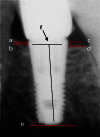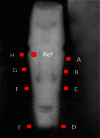A radiographic comparison of progressive and conventional loading on crestal bone loss and density in single dental implants: a randomized controlled trial study
- PMID: 23724215
- PMCID: PMC3666076
A radiographic comparison of progressive and conventional loading on crestal bone loss and density in single dental implants: a randomized controlled trial study
Abstract
Objective: Crestal bone loss is a biological complication in implant dentistry. The aim of this study was to compare the effect of progressive and conventional loading on crestal bone height and bone density around single osseointegrated implants in the posterior maxilla by a longitudinal radiographic assessment technique.
Materials and methods: Twenty micro thread implants were placed in 10 patients (two implants per patient). One of the two implants in each patient was assigned to progressive and the other to conventional loading groups. Eight weeks after surgery, conventional implants were restored with a metal ceramic crown and the progressive group underwent a progressive loading protocol. The progressive loading group took different temporary acrylic crowns at 2, 4 and 6 months. After eight months, acrylic crowns were replaced with a metal ceramic crown. Computer radiography of both progressive and conventional implants was taken at 2, 4, 6, and 12 months. Image analysis was performed to measure the height of crestal bone loss and bone density.
Results: The mean values of crestal bone loss at month 12 were 0.11 (0.19) mm for progressively and 0.36 (0.36) mm for conventionally loaded implants, with a statistically significant difference (P < 0.05) using Wilcoxon sign rank. Progressively loaded group showed a trend for higher bone density gain compared to the conventionally loaded group, but when tested with repeated measure ANOVA, the differences were not statistically significant (P > 0.05).
Conclusion: The progressive group showed less crestal bone loss in single osseointegrated implant than the conventional group. Bone density around progressively loaded implants showed increase in crestal, middle and apical areas.
Keywords: Dental Implant Loading; Dental Prosthesis; Implant-Supported.
Figures



Similar articles
-
A radiographic assessment of progressive loading on bone around single osseointegrated implants in the posterior maxilla.Clin Oral Implants Res. 2005 Apr;16(2):161-7. doi: 10.1111/j.1600-0501.2004.01089.x. Clin Oral Implants Res. 2005. PMID: 15777325 Clinical Trial.
-
Immediate versus conventional loading of variable-thread tapered implants supporting three- to four-unit fixed partial dentures in the posterior maxilla: 3-year results of a split-mouth randomised controlled trial.Int J Oral Implantol (Berl). 2019;12(4):449-466. Int J Oral Implantol (Berl). 2019. PMID: 31781699 Clinical Trial.
-
Crestal Bone Loss under Delayed Loading of Full Thickness Versus Flapless Surgically Placed Dental Implants in Controlled Type 2 Diabetic Patients: A Parallel Group Randomized Clinical Trial.J Prosthodont. 2018 Aug;27(7):611-617. doi: 10.1111/jopr.12549. Epub 2016 Oct 12. J Prosthodont. 2018. PMID: 27731955 Clinical Trial.
-
Do repeated changes of abutments have any influence on the stability of peri-implant tissues? One-year post-loading results from a multicentre randomised controlled trial.Eur J Oral Implantol. 2017;10(1):57-72. Eur J Oral Implantol. 2017. PMID: 28327695 Clinical Trial.
-
Immediate, early (3 weeks) and conventional loading (4 months) of single implants: Preliminary data at 1 year after loading from a pragmatic multicenter randomised controlled trial.Eur J Oral Implantol. 2015 Summer;8(2):115-26. Eur J Oral Implantol. 2015. PMID: 26021223 Clinical Trial.
Cited by
-
Hard and soft-tissue evaluation of bar-clip, ball-socket, and kerator attachments in mandibular implant overdenture treatment: An in vivo study.J Indian Prosthodont Soc. 2019 Oct-Dec;19(4):296-306. doi: 10.4103/jips.jips_143_19. Epub 2019 Oct 10. J Indian Prosthodont Soc. 2019. PMID: 31649438 Free PMC article.
-
Additional Manufactured Interim Restorations: a Review on the Literature.J Dent (Shiraz). 2022 Dec;23(4):424-437. doi: 10.30476/DENTJODS.2021.91503.1589. J Dent (Shiraz). 2022. PMID: 36718160 Free PMC article. Review.
-
Patient-, implant- and prosthetic-related factors on peri-implant mucositis and bone loss.Braz Oral Res. 2024 May 13;38:e040. doi: 10.1590/1807-3107bor-2024.vol38.0040. eCollection 2024. Braz Oral Res. 2024. PMID: 38747827 Free PMC article.
-
Coupling between Osseointegration and Mechanotransduction to Maintain Foreign Body Equilibrium in the Long-Term: A Comprehensive Overview.J Clin Med. 2019 Jan 25;8(2):139. doi: 10.3390/jcm8020139. J Clin Med. 2019. PMID: 30691022 Free PMC article. Review.
-
Effects of Immediate and Delayed Loading on the Outcomes of All-on-4 Treatment: A Prospective Study.J Dent (Tehran). 2016 Nov;13(6):415-422. J Dent (Tehran). 2016. PMID: 28243303 Free PMC article.
References
-
- Astrand P, Engquist B, Dahlgren S, Gröndahl K, Engquist E, Feldmann H. Astra Tech and Brånemark system implants: a 5-year prospective study of marginal bone reactions. Clin Oral Implants Res. 2004 Aug;15(4):413–20. - PubMed
-
- Adell R, Lekholm U, Rockler B, Branemark PI. A 15-year study of osseointegrated implants in the treatment of edentulous jaw. Int J Oral Surg. 1981 Dec;10(6):387–416. - PubMed
-
- Albrektsson T, Zarb G, Worthington P, Eriksson AR. The long-term efficacy of currently used dental implants. A review and prognosis criteria for success. Int J Oral Maxillofac Implants. 1986 Summer;1(1):11–25. - PubMed
-
- Buser D, Weber HP, Bragger U, Balsiger C. Tissue integration of one stage ITI implants:3-year results of a longitudinal study with Hollow-Cylinder and Hollow-Screw implants. Int J Oral Maxillofac Implants. 1991 Winter;6(4):405–12. - PubMed
-
- Albrektsson T, Buser D, Sennerby L.On crestal/marginal bone loss around dental implants Int J Periodontics Restorative Dent 2013January–Feb339–11. - PubMed
LinkOut - more resources
Full Text Sources
Medical
